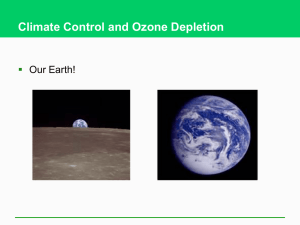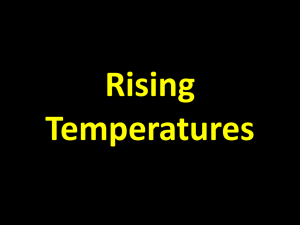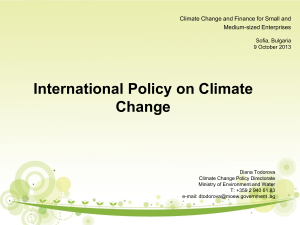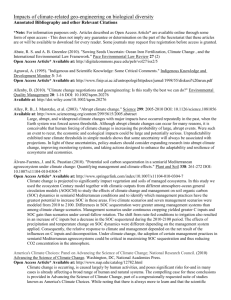Part 2 - Climate Change
advertisement
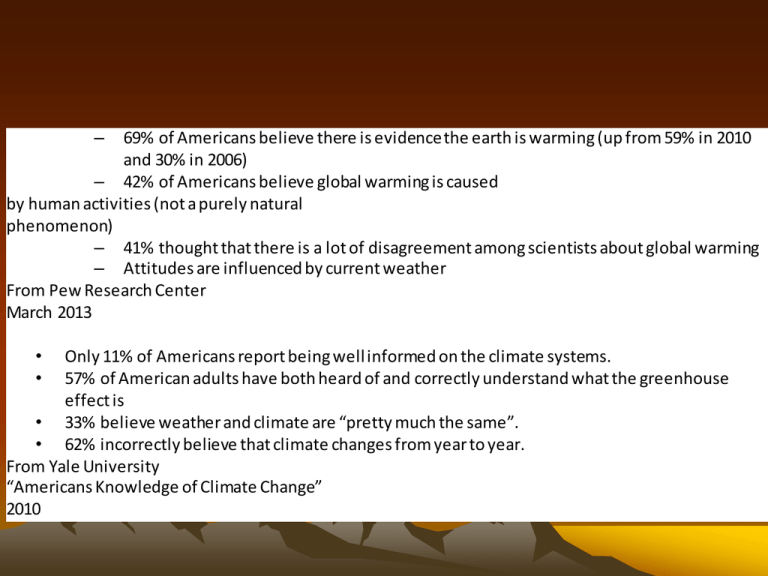
– 69% of Americans believe there is evidence the earth is warming (up from 59% in 2010 and 30% in 2006) – 42% of Americans believe global warming is caused by human activities (not a purely natural phenomenon) – 41% thought that there is a lot of disagreement among scientists about global warming – Attitudes are influenced by current weather From Pew Research Center March 2013 • • Only 11% of Americans report being well informed on the climate systems. 57% of American adults have both heard of and correctly understand what the greenhouse effect is • 33% believe weather and climate are “pretty much the same”. • 62% incorrectly believe that climate changes from year to year. From Yale University “Americans Knowledge of Climate Change” 2010 Major Greenhouse Gases and Climate Change • Increases in average concentrations of three greenhouse gases in the troposphere between 1860 and 2004, mostly due to fossil fuel burning, deforestation, and agriculture. Figure 20-5 Top 8 greenhouse gas emitters 1. Power plants 2. Industrial processes 3. Transportation 4. Agriculture 5. Fossil fuel extraction, processing and distribution 6. Residential and commercial buildings 7. Biomass burning 8. Waste disposal and treatment Climate Change • The Intergovernmental Panel on Climate Change, a U.N. scientific network, projects that temperatures will rise this century by up to 6.4 degrees Celsius (11.5 degrees Fahrenheit), depending on if and how much emissions are rolled back of carbon dioxide and other industrial, transportation and agricultural gases that are warming the atmosphere also known as greenhouse gases (GHG). Warmer temperatures in Alaska, Russia, and the Arctic are melting permafrost releasing more CO2 and CH4 into the troposphere. Scientific research indicates sea levels worldwide have been rising at a rate of 0.14 inches (3.5 millimeters) per year since the early 1990s. The trend, linked to global warming, puts thousands of coastal cities, like Venice, Italy, and even whole islands at risk of being claimed by the ocean. CLIMATE CHANGE AND HUMAN ACTIVITIES • Evidence that the earth’s troposphere is warming, mostly because of human actions: – The 20th century was the hottest century in the past 1000 years. – Since 1900, the earth’s average tropospheric temperature has risen 0.6 C° 1F °. – Over the past 50 years, Arctic temperatures have risen almost twice as fast as those in the rest of the world. – Glaciers and floating sea ice are melting and shrinking at increasing rates. How Do We Know What Temperatures Were in the Past? • Scientists analyze tiny air bubbles trapped in ice cores learn about past: – troposphere composition. – temperature trends. – greenhouse gas concentrations. – Solar output, snowfall, and forest fire activity. Figure 20-3 How Do We Know What Temperatures Were in the Past? • In 2005, an ice core showed that CO2 levels in the troposphere are the highest they have been in 650,000 years. Figure 20-4 EFFECTS OF GLOBAL WARMING • Between 1979 and 2005, average Arctic sea ice dropped 20%. • Therefore, a loss of sunlight reflectivity. The ocean absorbs more heat energy and warms waters to melt ice faster. Polar Ice Loss July 31, 2013 Greenland hits a new record High Temp : 25.9 C / 78.6 F Ocean Acidification The Carbon Dioxide - Bicarbonate Equilibrium CO2 dissolves rapidly in water, and reacts with water to form carbonic acid, which rapidly ionizes to form bicarbonate and carbonate. Dissolved CO2 causes water to become slightly acidic; The pH of sea water today is typically between 7.36 and 8.4, which is slightly basic. Buffering by bicarbonate and other ions is important in maintaining the correct pH. The photos below show what happens to a pteropod’s shell when placed in sea water with pH and carbonate levels projected for the year 2100. The shell slowly dissolves after 45 days CaCO3(s) + H+(aq) --> Ca2+(aq) + HCO3-(aq) The Biological Impacts Ocean acidification is expected to impact ocean species to varying degrees. Photosynthetic algae and seagrasses may benefit from higher CO2 conditions in the ocean, as they require CO2 to live just like plants on land. On the other hand, studies have shown that a more acidic environment has a dramatic effect on some calcifying species, including oysters, clams, sea urchins, shallow water corals, deep sea corals, and calcareous plankton. When shelled organisms are at risk, the entire food web may also be at risk. Today, more than a billion people worldwide rely on food from the ocean as their primary source of protein. Many jobs and economies in the U.S. and around the world depend on the fish and shellfish in our oceans. The below map shows the concentration of anthropogenic CO2 at the surface of the ocean. The concentration of "mmol kg-1" stands for millimoles of carbon dioxide per kilogram of sea water. A "mole" is a quantity measurement in chemistry that is equal to 6 x 1023 atoms or molecules. Since "milli" means one thousandth, a millimole would be 6 x 1020 atoms or molecules. So the red along the eastern coast of United States is 0.06 millimoles of carbon dioxide, which means 0.06 x 6x1020= 3.6 x 1021 molecules of carbon dioxide for each kilogram (about a liter) of ocean water. Rising Sea Levels • During this century rising seas levels are projected to flood low-lying urban areas, coastal estuaries, wetlands, coral reefs, and barrier islands and beaches. Figure 20-10 Rising Sea Levels • If seas levels rise by 9-88cm during this century, most of the Maldives islands and their coral reefs will be flooded. Figure 20-11 • Millions of the peoples living in Himalayan region are relying on the glacial melt waters from the Himalayan glaciers. A decline in glacier mass balance can mean less water available for rivers. It is a worry that the receding glacier trend could lead to the Ganga, Indus, Brahmaputra and other rivers in northern India becoming seasonal rivers. If these major rivers are dry during the summer months. It will affect the water supply for irrigation. Effects on Biodiversity: Winners and Losers • Life forms migrates or expand to “comfortable” regions (Zone of Tolerance) Droughts/Floods/Storms Positive Loop Feedback • When a part of the cycle is increased beyond “normal” it may lead to an increase in the cycle’s rate. • Increase in CO2 in atmospheric temperatures causes permafrost to melt which releases CH4 a rise in atmospheric temperatures which causes oceans to warm ocean CO2 sink stops greenhouse gas CO2 remains in atmosphere temperatures increase causes a drought may result in a major forest fire releases CO2 and reduces the forests that help store the CO2 … Kyoto Protocol • International Treaty • "The Kyoto Protocol is an agreement under which industrialised countries will reduce their collective emissions of greenhouse gases by 5.2% compared to the year 1990 . The goal is to lower overall emissions of six greenhouse gases - carbon dioxide, methane, nitrous oxide, sulfur hexafluoride, HFCs, and PFCs - calculated as an average over the five-year period of 2008-12. National targets range from 8% reductions for the European Union and some others to 7% for the US, 6% for Japan, 0% for Russia, and permitted increases of 8% for Australia and 10% for Iceland." This was mainly taken on by rich countries. Why? BUT….. • No United States president has signed it • Government says it will be a jolt to the economy. • Even with the EPA rules, the amount of air pollution in the US has increased. • If current trends continue, the amount of pollutants in the air would be 43% higher by 2020. National Participation • • • • • • Kyoto Protocol participation map (commitment period: 2013-2020) Parties; Annex I & II countries with binding targets Parties; Developing countries without binding targets States not Party to the Protocol Signatory country with no intention to ratify the treaty, with no binding targets Countries that have renounced the Protocol, with no binding targets Parties with no binding targets in the second period, which previously had targets Climate Conferences • In 2014 a Lima Peru will host the 20th yearly session of the Conference of the Parties (COP) to the 1992 United Nations Framework Convention on Climate Change(UNFCCC) and the 10th session of the Meeting of the Parties (CMP) to the 1997 Kyoto Protocol (the protocol having been developed under the UNFCCC's charter) • A disagreement between the United States and China has stalled progress on this central element of any global climate deal. For the past 13 years, the U.S. has refused to join the rest of the industrialized world in the Kyoto Protocol, a binding pact to curb fossil-fuel emissions by modest amounts, due to expire in 2012. More recently, as China, India and other emerging economies exempted from the 1997 Kyoto pact have sharply increased emissions, they have rejected calls by the U.S. and others to commit by treaty to restraints. Climate Conferences • Significant progress has been identified as possible in three key areas: • 1. Establish a multibillion-dollar fund to aid poorer countries to adapt to climate change and to install clean energy sources. • 2. Agree on more elements of a complex plan to pay developing countries to protect their forests. • 3. Make it easier for poorer nations to obtain patented technologies from the industrialized world for clean energy and climate adaptation. What Can You Do? Reducing CO2 Emissions • Use less electricity – Won’t somebody think of the Polar Bears? • Use energy-efficient windows • Use energy-efficient appliances and lights • Heavily insulate your house and seal all drafts • Reduce garbage by recycling and reuse • Insulate your hot water heater • Use compact fluorescent bulbs • Plant trees to shade your house during summer • Set water heater no higher than 49°C (120°F) • Wash laundry in warm or cold water • Use low-flow shower head • Buy products from companies that are trying to reduce their impact on climate • Drive a fuel-efficient car, walk, bike, carpool, and use mass transit Fig. 20-16, p. 485 Carbon Sequestration • • • • • • • • • What is Carbon Trading? also known as cap and trade The cap is an enforceable limit on emissions that is usually lowered over time — aiming towards a national emissions reduction target Carbon Trading is a market based mechanism for helping mitigate the increase of CO2 in the atmosphere. Carbon trading markets are developing that bring buyers and sellers of carbon credits together with standardized rules of trade. Who are potential buyers for Carbon credits? Any entity, typically a business, that emits CO2 to the atmosphere may have an interest or may be required by law to balance their emissions through mechanism of Carbon sequestration. These businesses may include power generating facilities or many kinds of manufacturers. Who are potential sellers of Carbon credits? Entities that manage forest or agricultural land might sell carbon credits based on the accumulation of carbon in their forest trees or agricultural soils. Similarly, business entities that reduce their carbon emission may be able to sell their reductions to other emitters. Who does this website target? In effect, the buyer is paying a charge for polluting, while the seller is being rewarded for having reduced emissions. Thus, in theory, those who can reduce emissions most cheaply will do so, achieving the pollution reduction at the lowest cost to society.[ Carbon Credit Trading • As more governments begin to cap carbon emissions and initiate trading schemes, there will need to be regulatory bodies that measure and confirm reduced emissions. And those agencies will need new instruments and technologies to measure and record. • Carbon trading is one of the "fastest-growing specialties in financial services." And companies are scrambling to get "a slice of a market now worth about $30 billion and that could grow to $1 trillion within a decade." Carbon Credit Trading • Every year humans generate about 38 billion tons of carbon dioxide • At its current price of about $3.50 per ton, the potential carbon market stands at roughly $133 billion (38 billion x $3.50). The burning of fossil fuels releases 11 BILLION TONS of carbon dioxide into the atmosphere every year. What would this volume look like. http://www.independent.co.uk 47 http://www.babble.com







